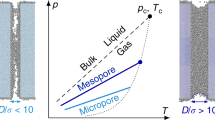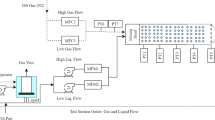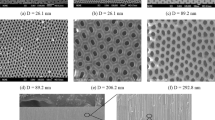Abstract
JUST as Knudsen and others1 have shown for single capillaries, flow of a gas through a porous medium also undergoes a transition from viscous flow to molecular flow when pore diameters become comparable in size with the mean free path of the gaseous molecules. The position has been reviewed recently2, but more data in the molecular flow region are desirable. I have therefore been studying the flow of various gases through plugs of 'Linde silica', a finely divided, amorphous silica stated by the makers to have a maximum particle size of 0.05 µ. The experiments cited here were carried out on a single plug compressed to a porosity (ϵ) of 0.678. The specific surface, S0, calculated from the permeability equation of Carman and Arnell2, was 2.35 × 106 cm.2/cm.3. This gives an equivalent pore diameter which was usually well below the mean free path of the various gases studied. Application of the Brunauer—Emmett—Teller calculation3 to gas adsorption isotherms gave S0 = 2.8 × 106 to 4.1 × 106 cm.2/cm.3, indicating that particles possibly possess an internal surface which is not accessible to flow. To cover a wide range of molecular weights, flow-rates were measured at 22° C. for hydrogen, air, carbon dioxide and 'Freon-12', CF2Cl2, all of which gave consistent values for S0.
This is a preview of subscription content, access via your institution
Access options
Subscribe to this journal
Receive 51 print issues and online access
$199.00 per year
only $3.90 per issue
Buy this article
- Purchase on Springer Link
- Instant access to full article PDF
Prices may be subject to local taxes which are calculated during checkout
Similar content being viewed by others
References
Loeb, A., "Kinetic Theory of Gases", 290 (2nd ed., McGraw-Hill, 1934).
Carman and Arnell, Can. J. Res., 26A, 129 (1948).
Brunauer, Emmett and Teller, J. Amer. Chem. Soc., 60, 309 (1938).
Tomlinson and Flood, Can. J. Res., 26B, 38 (1918).
Author information
Authors and Affiliations
Rights and permissions
About this article
Cite this article
CARMAN, P. Flow of Adsorbed Molecules. Nature 163, 684–685 (1949). https://doi.org/10.1038/163684a0
Issue Date:
DOI: https://doi.org/10.1038/163684a0
Comments
By submitting a comment you agree to abide by our Terms and Community Guidelines. If you find something abusive or that does not comply with our terms or guidelines please flag it as inappropriate.



